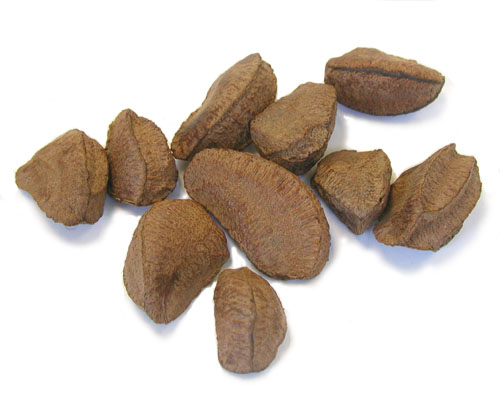Brazil Nuts

It has been known since the 1930s that Brazil nuts contain relatively large concentrations of barium (approximately 0.1-0.3% by weight). In our laboratory we measured the barium content in the meat (endosperm) of the nut at close to 0.3%. That Brazil nuts also contain high levels of radium was first reported in the 1950s (Turner et al 1958). Barium and radium are group II elements and their chemical behavior is very similar.
The difference between the barium and the radium is that radium is radioactive. To be specific, the radium in Brazil nuts is a mix of Ra-226 and Ra-228. Of course, the various decay products of Ra-226 and Ra-228 are also present. Although the radioactivity is not high enough to be detectable with a simple survey instrument, a one to five minute count on the powdered meat of the nut with a pancake GM or ZnS detector connected to a scaler will indicate that the beta and alpha activities are significantly above background.
Brazil nuts are the seeds of Bertholletia excelsa, a large tree that is grown in various parts of world, not just Brazil. The nuts, in groups of 12 to 25 much like the sections of an orange, form the globular (4-6” diameter) fruit of the tree. It is not true, as is sometimes thought, that the high concentration of radium in Brazil nuts is due to elevated levels of the uranium and/or thorium series in the soil in which the tree grows. The accumulation of the radium (and barium) is due to the very extensive root system of the tree. For what it’s worth, measurements by Penna-Franca et al indicated that higher radium concentrations are found in the leaves and cork of the tree than in the nut.
The Brazil nut has a high lipid (ca. 60%) and protein (ca. 15%) content. The calcium content is ca. 0.2%.
Radium Content
As might be expected, the reported concentration of Ra-226 and Ra-228 vary, but overall, the radium concentrations in Brazil nuts are 1,000 times higher than those in other foods. The following are representative of some of the measurements that have been performed:
- Turner et al (1958): approximately 1.8 pCi/g Ra-226
- Penna-Franca (1959): approximately 2 pCi/g Ra-228
- Penna-Franca et al (1968):
- 075-3.6 pCi/g Ra-226 in the nut (3.1-113.5 pCi/g in ash of nut)
- 16- 3.6 pCi/g Ra-228 in the nut (5.3-114.5 pCi/g in ash of nut)
- Smith (1971): up to 6.6 pCi/g Ra-226 in the nut
- Gabay and Sax (1969) determined that most of the radium of ingested Brazil nuts was not retained by the body.
References
- Drury et al. Radioactivity in Food Crops. ORNL-5963. 1981.
- Eisenbud, M., Gesell, T. Environmental Radioactivity. Academic Press. 4th edition; 1997.
- Gabay, J.J., Sax, N.I. Retention of radium due to ingestion of Brazil Nuts. Health Physics 16: 812-813; 1969.
- Smith, K.A. The Comparative Uptake and Translocation by Plants of Calcium, Strontium, Barium, and Radium. Plant and Soil 34:369-379; 1971.
- Turner, R.C., Radley, J.M. Mayneord, V.W. The Naturally Occurring Alpha Ray Activity of Foods. Health Physics 1: 268-275; 1958.
- Penn-Franca, et al. Radioactivity of Brazil Nuts. Health Physics 14: 95-99; 1968.
